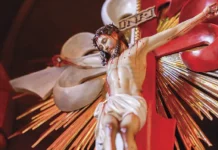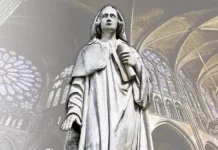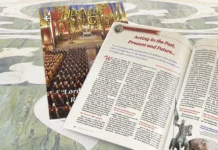From the profane to the sacred, musical instruments help to create an ambience in keeping with the festive or recollected moments of liturgical acts, preparing souls for a loving encounter with God.
When the simplicity of ferial days gives way to the splendours of the liturgical solemnities, man’s gifts and senses are harmonized in acts of adoration which allow the soul to be imbued with the divine and to manifest, through melody, his love for the Creator.
The harmonious voices of a well-tuned choir, accompanied by the organ or other modulated instruments, and sometimes interspersed with triumphal trumpet flourishes, constitute a true prayer, if aimed at the glory of God.
However, when instrumental music is strong to the ears, the true connoisseurs of plainsong will recall – not without nostalgia – the monodic gravity of the Gregorian chant sung a cappella. The austerity of its melodic line, governed by a rhythm without measures, seems more apt to make the grandeur and elevation of the Sacred Mystery felt.
In the face of this paradox, it is worth asking how instruments came to join the choir in the Liturgy, thus inaugurating a new genre of sacred music. What is their function? Do they really help to bring the soul closer to heavenly harmonies?
Musical instruments in the early Church
Musical instruments were very much present in Jewish worship, as is confirmed by such Old Testament passages as this: “Praise the Lord with the lyre, make melody to Him with the harp of ten strings! Sing to Him a new song, play skilfully on the strings” (Ps 33:2-3).
Sacred Scripture also attributes to them a healing and exorcistic effect – it was the chords of David’s lyre that freed Saul from the evil spirit (cf. 1 Sam 16:16-23) – while their absence was considered an unmistakable sign of misfortune about to fall upon the chosen people: “And I will stop the music of your songs, and the sound of your lyres shall be heard no more” (Ez 26:13).
“This Hebrew tradition relating to musical instruments did not, however, pass into the early Church; at least the apostolic writings and those immediately following make no reference to it.”1 Although Christians were aware of the Hebrew custom, its assimilation into divine worship was repudiated.
Some authors claim that the cessation in the use of instruments was a prudent measure, to avoid drawing attention to places of worship in times of persecution. However, the main reason for their rejection seems to have been their use in idolatrous cults and pagan feasts: “They were probably banished from the temple for their profane, sensual and clamorous character,”2 Msgr. Mario Righetti declares in his famous History of the Liturgy.
Clement of Alexandria argued that, in order to glorify God, Christians needed only one instrument, the Word, the bearer of peace.3 He saw “in the homophony of sacred chant an image and parallelism with the harmony of the universe and the heavenly spheres,”4 while the heterophony between chant and instruments was considered contrary to the unity of the Christian community.
An irreconcilable separation was thus established in the early days of Christianity between sacred song and instrumental melodies. Perhaps this dichotomy originated from a divine impetus, which subdued the immoderate impulses of profane music to allow Gregorian chant to emerge and reach its full splendour, and its neumes to combine in serene and peaceful melodies.
Only the organ was worthy to accompany the prayers of the Church starting from the seventh century,5 “since it is especially fitted for the sacred chants and sacred rites. It adds a wonderful splendour and a special magnificence to the ceremonies of the Church. It moves the souls of the faithful by the grandeur and sweetness of its tones. It gives minds an almost heavenly joy and it lifts them up powerfully to God and to higher things.”6
Two parallel paths
The solid empire established by Gregorian chant in sacred music came under threat from the 11th century onwards by the wave of troubadours that arose in Europe, generating profound changes in human mentality.7
Not long after, “the figure of the saints faded away in the face of combats, and Marian cult gave way to ‘courtly love’. Little by little, Latin was abandoned in favour of the vernacular, accessible to all. Poetry and music gained a new popularity, fatally lacking to Latin ecclesiastical chant.”8
Born in the same cradle as profane songs, musical instruments progressed and were perfected, wrapped in worldly arms. They began to shine at feasts, their melodies blending pleasantly with the sentimental vanity of tournaments and popular games.
With all the more reason, they were far from resounding in the churches…
Sacred polyphony and the oratorios
Meanwhile, the history of sacred vocal music was following its course. From the Gregorian monody it evolved into counterpoint and the diversity of melodic lines. In the 16th century, ineffable beauty was achieved by composers such as Tomás Luis de Victoria and Giovanni Pierluigi da Palestrina, whose profound and recollected spirit saved sacred polyphony from the exaggerations to which it was exposed.

It was also at that time that “the sounds of the organ and other musical instruments were joined with the voices of the singers.”9 The strict separation maintained for centuries was gradually attenuated. Small ensembles of instruments appeared, which first played in unison with the voices and soon after had their own part in the accompaniment.10
Nevertheless, if singing had penetrated deeply into the heart of man, helping him to express his religious sentiments, the instruments were not yet able to reflect by themselves the movements of the human soul. “At first they did not speak a language, but babbled rhetorical imitations of vocal music, both of the austere and pure music of the Church as well as the joyful and carefree popular songs.”11
The presence of instruments in sacred music underwent a marked increase when the era of oratorios began. Heinrich Schütz (1585-1672), considered a composer of transition between polyphony and oratorios, knew how to masterfully unite voices with all the orchestral resources at his disposal, foreshadowing the apogee of the new musical genre, which came about with the inspirations of George Frideric Handel (1685-1759).
Although the latter did not dedicate his works to divine worship, but rather to presentations of a religious nature in secular surroundings, we cannot fail to recognize in many of his compositions his brilliance in putting the Word of God to music, which earned him the title of “Sacred Scripture composer.”12 His masterpiece, Messiah, clearly attests to this.
Seeking sapiential balance
Since they were already accompanying not only human voices, but also, in oratorios, the Word of God, musical instruments gradually passed from the theatre to the church, finally gaining citizenship in the heavenly Jerusalem. In the middle of the 18th century, Pope Benedict XIV confirmed that they supported liturgical singing.13
However, not everything in the art of sacred music had not entered into its proper balance, for during the 19th century, church use of orchestral music began to foment abuses, turning the house of God into a continuation of the theatre, compromising the sober and tranquil character of liturgical prayer and endangering the integrity of ecclesiastical singing.14
Now, abuse should not prevent use. To remedy this evil, the just prudence of St. Pius X exhorted that the choice of instruments, especially wind instruments, should be limited, judicious and proportionate to the environment, and that compositions should be of a serious and appropriate style, similar in all respects to those written for the organ,15 for there are some styles more suited to sacred worship than others. Moreover, “as the singing should always have the principal place, the organ or other instruments should merely sustain and never overshadow it.”16
Pius XII reinforced the need for this balance by teaching that “besides the organ, other instruments can be called upon to give great help in attaining the lofty purpose of sacred music, so long as they play nothing profane, nothing clamorous or strident and nothing at variance with the sacred services or the dignity of the place.”17
Post-conciliar sacred music
The 20th century witnessed profound changes in the ambit of culture, and sacred music was unfortunately not immune to them.
In its document dedicated to the Liturgy, the Second Vatican Council reiterates the admission into divine worship of other musical instruments besides the organ,18 while encouraging popular religious songs “so that in devotions and sacred exercises, as also during liturgical services, the voices of the faithful may ring out.”19 But it safeguards the integrity of Gregorian chant “as specially suited to the Roman Liturgy.”20

in Mount Carmel House, Caieiras (SP)
There was therefore nothing new in relation to the preceding Magisterium. However, the panorama of sacred music changed radically in the post-conciliar period: “Especially in the first twenty years of the reform, we witnessed a disproportionate transposition of melodies from the profane sphere, or rather, from the religious or catechetical sphere to the church. […] The only criterion that prevailed was that it be a catchy, rhythmic and lively melody in which the people participate.”21
Wisely analysing the excesses which occurred at that time, which still largely contaminate many liturgical celebrations, Benedict XVI recalls that in sacred music it is always necessary to preserve “the sense of prayer, of dignity and of beauty; full adherence to the texts and to the liturgical gestures; the involvement of the assembly, hence a legitimate adaptation to the local culture while preserving the universality of the language.”22
Today, these important criteria “should be taken into careful consideration.” They do not contradict but reinforce “the primacy of Gregorian chant as a supreme model of sacred music and the wise use of other modes of expression that are part of the Church’s historical and liturgical patrimony.”23
Rich, profound and harmonic act of praise
Finally, let us leave aside considerations of musical instruments in human history and look at them from the perspective of the Creator.
“Instrumental music contributes, in an exceptionally effective way, to create an ambience in keeping with festive or recollected moments,”24 comments a contemporary author. It effectively prepares the soul to elevate itself to God, for a great orchestra resounding in prayer within the church can well symbolize the soul of the Church, rendering to the Creator a rich, profound and harmonious act of praise.
In a musical ensemble, there are string and wind instruments. Among the latter, there is yet a very marked difference between wood and brass. Although the harmony of the ensemble is always better than the parts, nevertheless, how beautiful it is to hear each instrument separately, experiencing the uniqueness of the timbres and resonances expressing different states of soul.
If an inspired composer were to set the gest of Elijah the prophet to music, he would certainly employ the gentle nobility of the woodwinds to convey the murmur of the light breeze that preceded his encounter with God (cf. 1 Kgs 19:12-13). If, on the contrary, he wished to musically portray the fire of the Lord that devoured the wood, stones, dust, water and the victim on the altar of Mount Carmel (cf. 1 Kgs 18:38), he would undoubtedly use the brass instruments, which resound as a manifestation of the implacable divine justice. On the other hand, only strings would be able to express the depth of the reciprocal affection between Elijah and Elisha when the chariot of fire carried away the master from the disciple (cf. 2 Kgs 2:11-12).
However, when God speaks, only the organ is worthy to accompany Him. By bringing together simplicity and variety, this grandiose instrument forms a balanced, sublime and perfect ensemble of the most varied timbres and sounds.

A language everyone can understand
Contemplated in this way, instrumental music constitutes a form of prayer that touches the very depths of souls through a wordless language that all men are capable of understanding.
“Unfortunately,” comments Pope Benedict XVI, “after the events of the Tower of Babel, languages separate us; they create barriers. But we have just seen and felt that a part of the world exists that was not destroyed, even after the Tower and the pride of Babel, and it is music: the language we can all understand, because it moves all our hearts.”25
The glorification of the divine perfections through music is not, therefore, “only a guarantee to us that the goodness and beauty of God’s creation have not been destroyed but that we are called and are capable of working for the good and the beautiful, and it is also a promise that the future world will see that God wins, that the beautiful and the good win.”26 ◊
Notes
1 RIGHETTI, Mario. Historia de la Liturgia. Madrid: BAC, 1955, v.I, p.630.
2 Idem, ibidem.
3 Cf. CLEMENT OF ALEXANDRIA. Le Pédagogue. L.II, c.4, n.42, 3: SC 108, 93.
4 RIGHETTI, op. cit, p.631
5 The introduction of the organ into liturgical worship is traditionally attributed to Pope St. Vitalian, who reigned as Pontiff from 657 to 672.
6 PIUS XII. Musicæ sacræ disciplina, n.58.
7 Cf. DELLA CORTE, A.; PANNAIN, G. Historia de la música. De la Edad Media al siglo XVIII. Barcelona: Labor, 1950, t.I, p.143.
8 PAHLEN, Kurt. La grande aventure de la musique. Verviers: Gérard & Co, 1947, p.48.
9 PIUS XII, op. cit., n.15.
10 Cf. RIGHETTI, op. cit., p.631.
11 DELLA CORTE; PANNAIN, op. cit., p.579.
12 PAHLEN, op. cit., p.127.
13 Cf. BENEDICT XIV. Annus qui hunc, n.12.
14 Cf. RIGHETTI, op.cit., p.631.
15 Cf. ST. PIUS X. Tra le sollecitudini, n.20.
16 Idem, n.16.
17 PIUS XII, op. cit., n.59.
18 Cf. SECOND VATICAN COUNCIL. Sacrosanctum Concilium, n.120.
19 Idem, n.118.
20 Idem, n.116.
21 ALCALDE, Antonio. Canto e música litúrgica: reflexões e sugestões. 2.ed. São Paulo: Paulinas, 2000, p.44-45.
22 BENEDICT XVI. Letter to the Grand-Chancellor of the Pontifical Institute of Sacred Music, on the occasion of the centneary of its founding, 13/5/2011.
23 Idem, ibidem.
24 DUCHESNEAU, Claude; VEUTHEY, Michel. Musique et Liturgie. Le document “Universa laus”. Paris: Du Cerf, 1988, p.90.
25 BENEDICT XVI. Greeting at the end of the concert in his honour, at the Pontifical Palace of Castel Gandolfo, 2/8/2009.
26 Idem, ibidem.







